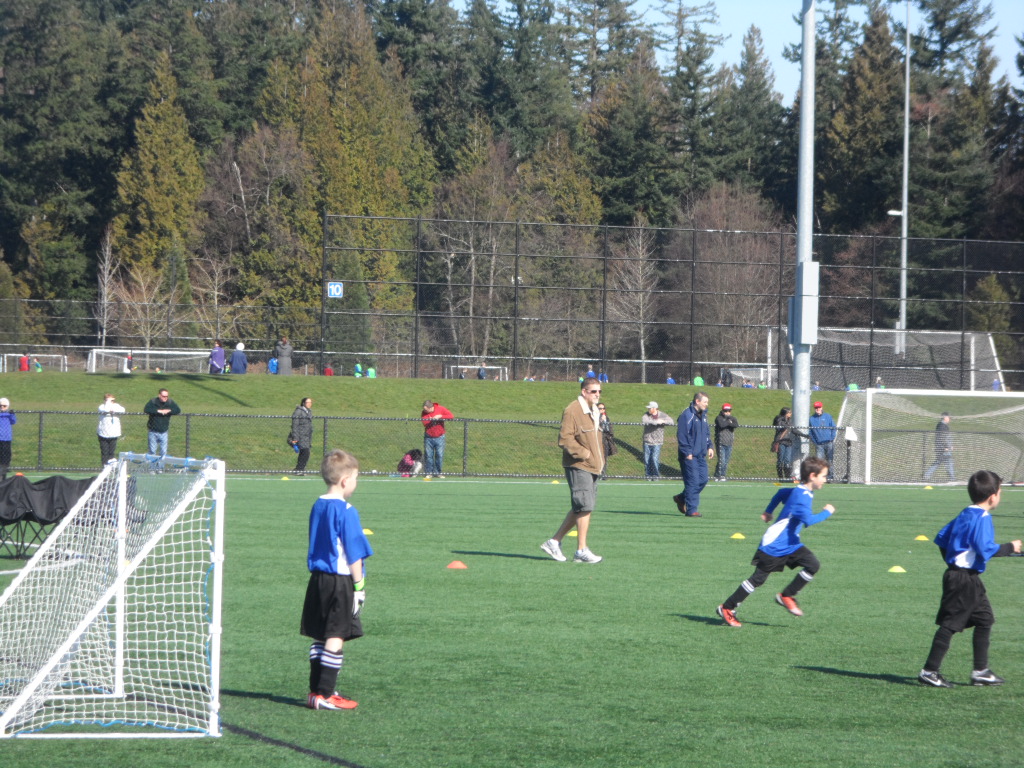
“Help! I coach very young players (4-6 year olds). It is really hard to keep their attention. Can you suggest some drills that I can work with them on?” – Lydda
Lydda you do not need any help – what you need is lots of PATIENCE. It is rather sad that we organize this wonderful sport at such a young age. But, that is not your concern.
However, it would be great if your administrators made every effort to just organize PLAY DAYS for the children in your age group. That is, have a Saturday when the children are dropped-off at the playground. Yes, have the parents go home and enjoy some quality time together – while their children are outside in a safe environment – PLAYING!
Now to answer your question: Do not look for any ‘drills’ to keep these children active. All soccer players including your 4-5 year olds come to practice to PLAY! So make your first goal to: KEEP the PLAYERS and the SOCCER BALL MOVING in other words KEEP THEM ACTIVE – ALL THE TIME!
Keep these two (2) thoughts in mind:
And these are proven facts! So, teach them our ‘9-Step Practice’. That is, PATIENTLY teach them our ‘ROUTINE’. I have written other articles that you can find on FundamentalSoccer.com; but, let me take the time and give you the flow chart.
Your First Few Practice “Theme” – “Keeping the Balls Moving and the Players Active”
1. Begin Practice – by letting the children socialize and tell them the ‘practice’ rules.
2. Warm-up – Have each player dribble their ball in a confined area & (pretend) stretch ever once in a while.
3. ONE + ONE (Cooperative Play) – Teach them ‘how to’ attack one goal and defend their own goal. PATIENTLY Teach them ‘how to’ play against each other, allow them to make-up their own rules.
4. ONE vs. ONE (Competitive Play) – See if they learned ‘how to’ attack one goal and defend their own goal. (Reminder- It takes time to learn everything)
5. HALF TIME ROUTINE – Teach them (PATIENTLY) what will happen at halftime. – Drink water (no oranges, not enough liquid) – Socialize and give them compliments (away from Mom & Dad)
6. Small Sided Games (Cooperative & Competitive Games) – Split them into groups of 2 or 3 vs. 1 or 2. Talk to them during the Cooperative phase and teach them ‘how to’ attack and defend the appropriate goal. Leave them alone during the Competitive phase and allow them to fail their way to success.
7. Scrimmage (Cooperative & Competitive) – Talk to them during the Cooperative phase and teach them ‘how to’ attack and defend the appropriate goal. Leave them alone during the Competitive phase and allow them to fail their way to success. When competition starts leave them alone and watch them be the best they can be. Don’t get discouraged if some decide to ‘stop’ and watch the clouds ‘go by.’
8. COOL DOWN – Pretend that they are ‘stretching’ their muscles – just like the big players and give every individual a compliment.
9. END PRACTICE – Praise the team – Review what they learned – Give a home-play assignment and let them know of the next team activity. (Be Brief)
If you stick to this ‘ROUTINE’ you will find that as the children begin to understand what is expected and they will become more and more attentive.
It is just like learning to play a computer game. At first they were hesitant until they figured out ‘hey I can hit these keys as hard and as many times as I want’ and Mom and Dad did not get mad. Also, the computer game is very slow and simple at the first level – to allow the child to be successful. With that success and understanding the game increases in challenge at level two. I’m sure you know the progression after that!
Now here is the real secret – once the child is finished playing the game (that day) and they come back. Where do they have to start again? Yes, they need to start again at the very slow (level one). And you realize that in several weeks they can almost do level one without looking at the keys or the monitor. That is ‘true’ understanding and putting the subconscious into play (but, we are getting rather technical here).
To keep it simple…Make your first goal – to teach the children ‘how to’ keep the ball and themselves moving…make sure they eventually go to attack one goal and also defend their own goal. Teach them the “ROUTINE” and with lots of PATIENCE you will find your very young players actively PLAYING in your practices.
If you keep changing (from drill to drill) they will not understand what you want and you cannot build on that…
No Understanding = No Learning … That is the bottom line!!!
Final Note: Thank you for taking the time to read this article and Sharing it with your soccer community. Clicking Like and Commenting on this subject is also very much appreciated
Your FUNdamental,
Koach Karl (Karl Dewazien)
Farpost Soccer Goals Ltd. prides itself on building soccer goals that soccer coaches and soccer clubs are always 100% thrilled with. If you are interested in buying aluminum soccer goals, please visit our online soccer goal store. Our high quality portable goals are used by clubs across North America, they are built for competitions, small sided soccer, soccer practice, tournaments, tryouts, and training at home!
If you have any questions or require any assistance, please don’t hesitate to contact us!